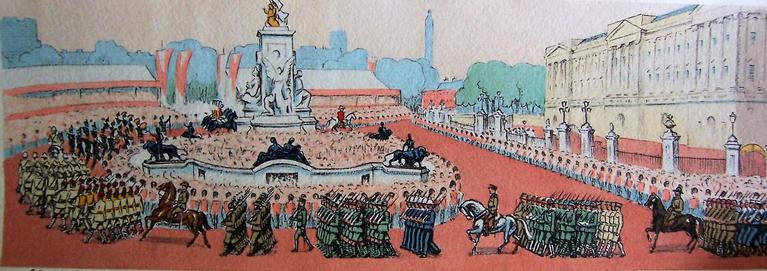Blog
1 June 2022

On the eve of the Queen’s extraordinary Platinum Jubilee, two curious items in Emmanuel’s collection of illustrated books come into their own as memorabilia of earlier landmark royal occasions during the Queen’s childhood.
These are two ‘panoramas’ issued to commemorate the Silver Jubilee of King George V and Queen Mary in 1935 and the Coronation of King George VI and Queen Elizabeth in 1937. Both stored in their own bespoke drum containers, the Jubilee panorama unrolls to a length of around 3.5 metres (11.5 feet), and the Coronation panorama is much longer at nearly 5.5 metres (18 feet).
.jpg)
.jpg)
To see them unrolled on a table in the Graham Watson Room gives an idea of their size, as also of how narrow is the illustrated strip at around 11.5 cms (4.5 ins). Printed in collotype and stencil, and then hand-coloured after drawings by Mary McNeile, they were issued in limited editions of 100 for the Jubilee and 125 for the Coronation (with 25 and 30 copies respectively reserved for sale in the USA).
Spoiled as we now are for access to both images and moving images, it is easy to undervalue the attraction of these panoramas in their time as mementoes of one of the characterizing features of these national celebrations: the procession. Queen Victoria’s Diamond Jubilee in 1897 had included a vast six-mile procession from Buckingham Palace to St Paul’s and set a precedent.
The narrow strip proportions of both panoramas are designed to highlight the carriage processions through the streets of London past familiar landmarks. The panorama of the 1935 Jubilee – the first silver jubilee to be celebrated – includes illustrations showing Princess Elizabeth, then nine years old, with her parents, the Duke and Duchess of York, passing Carlton House Terrace on the Mall.
.jpg)
.jpg)
Ahead of them in the procession are King George V and Queen Mary, shown passing Marlborough House, further along the Mall.
As its much greater length suggests, the Coronation panorama of two years later is more ambitious and full of detail. The Jubilee panorama shows the procession headed by the Life Guards marching round the still relatively new Victoria Memorial of 1911.
.jpg)
.jpg)
The Coronation panorama of the same scene has captions detailing the contingents of troops from Burma, Southern Rhodesia, Newfoundland, South Africa, New Zealand and Australia circling the Victoria Memorial, watched by vast crowds. The newly crowned King and Queen are shown passing Westminster Hall in the Gold State Coach.
.jpg)
.jpg)
Carriages carrying members of the Royal Family are shown passing Nelson’s Column in Trafalgar Square.
A procession of ‘Prime Ministers and Empire Representatives’ is depicted about to pass Fortnum and Mason in Piccadilly.
.jpg)
.jpg)
Troops of the Indian Army and the Band and Pipes of the First Highland Light Infantry are shown passing through the Wellington Arch and past Apsley House on Hyde Park Corner.
Another memento of a new reign is Edward Bawden’s The Queen’s Beasts (1953) in Emmanuel’s Chapman Collection of twentieth-century private press books. Very evocative of 1950s design, this book records in striking linocuts the ten six-foot-high heraldic animals – including dragon, unicorn and griffin – that were created out of plaster to stand sentinel at the entrance of Westminster Abbey at the Coronation of 1953. They were inspired by Henry VIII’s King’s Beasts that still stand at the entrance to Hampton Court Palace, but the heraldry was completely recast to represent the lineage of Elizabeth II. The actual Beasts at the Abbey were left as white plaster apart from the brilliantly coloured heraldic shields and badges that they held, but Bawden and his collaborator Cecil Keeling have depicted the beasts in bold colouring as rich as the shields they bear. These included the Lion of England and the Griffin of Edward III, bearing a badge with the Round Tower of Windsor Castle, adopted as the badge of the House of Windsor in 1938.
.jpg)
.jpg)
Also there was the Red Dragon of Wales, adopted by Henry VII as a Tudor emblem, together with the White Horse of Hanover.
.jpg)
.jpg)
The Queen’s Beasts greeted the young Queen as she arrived to be crowned, near the beginning of those seventy years of dedicated service that are being honoured and celebrated this year and this week.
God Save The Queen!
Barry Windeatt (Keeper of Rare Books)
Images by Helen Carron (College Librarian)
